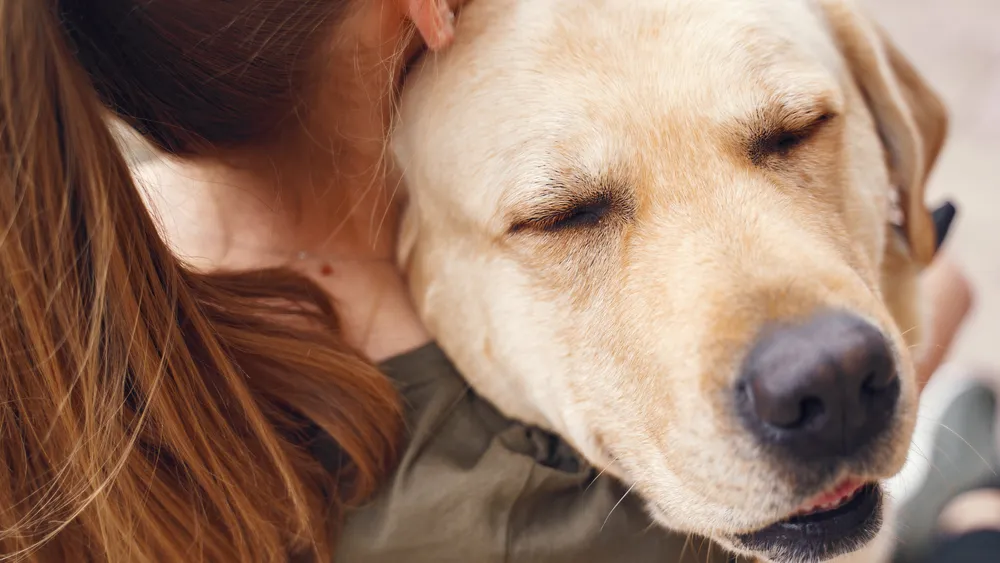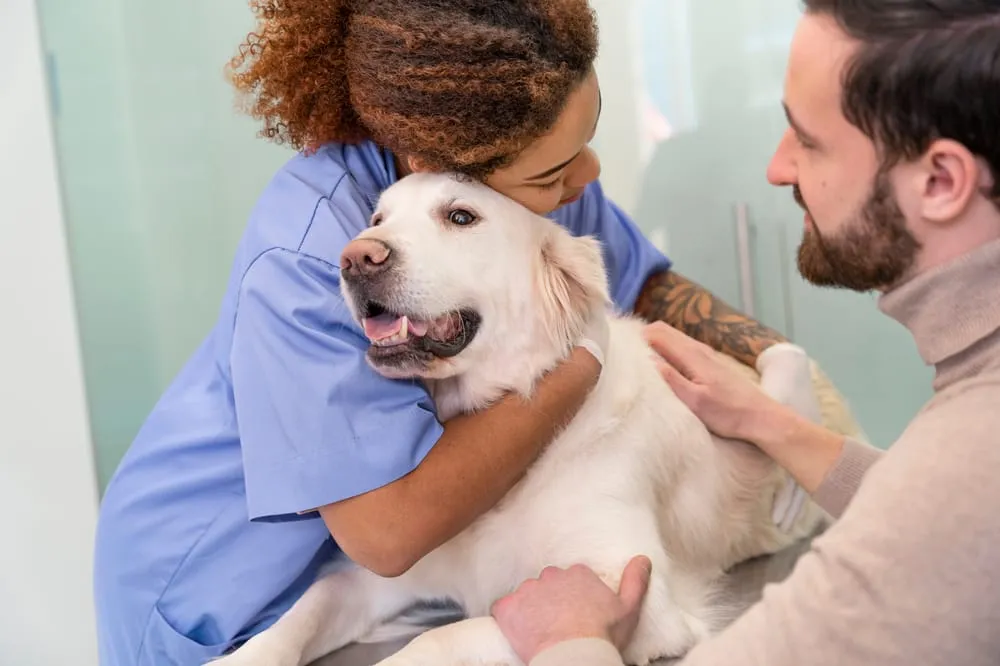Strokes in dogs, much like in humans, are a serious medical condition that can have significant health implications. Although less common in dogs than in humans, strokes still pose a real risk to our canine companions. A stroke occurs when the blood supply to the brain is compromised, either due to a blockage (ischemic stroke) or bleeding (hemorrhagic stroke).
This interruption can lead to brain damage, affecting a dog's physical and neurological functions. Recognizing the symptoms of a stroke in dogs is crucial for pet owners, as early detection and prompt veterinary intervention can greatly improve the chances of recovery. Symptoms can be subtle or sudden and understanding these signs is key to ensuring the well-being of our pets. This article aims to shed light on the warning signs of a stroke in dogs, guiding owners on how to recognize and respond to this medical emergency effectively.

Understanding What a Stroke Is
In dogs, a stroke occurs when there is an interruption of blood flow to the brain, leading to a sudden loss of neurological functions. This condition can have profound effects on a dog's health, impacting their physical abilities and behavior.
Types of Strokes in Dogs
- Ischemic Strokes: These are caused by a blockage in the blood vessels, preventing blood from reaching the brain. This blockage could be due to blood clots or a buildup of fatty deposits in the arteries.
- Hemorrhagic Strokes: These occur when a blood vessel in the brain bursts, leading to internal bleeding. This type can be more severe due to the damage from both the lack of blood flow and the pressure from bleeding.
Causes and Risk Factors
The causes of strokes in dogs can vary and are sometimes difficult to pinpoint. Potential causes include:
- Heart disease, which can lead to blood clots.
- High blood pressure, often a result of kidney disease or hormonal imbalances.
- Head injury or trauma leading to bleeding in the brain.
- Certain infections or inflammatory diseases.
- Cancer, which can lead to abnormal growths interfering with blood flow.
Certain risk factors can increase a dog's likelihood of suffering a stroke. These include advanced age, underlying health conditions like diabetes or Cushing's disease, and certain breeds that may be predisposed to blood clotting disorders.
Understanding what a stroke is and recognizing the potential causes and risk factors are key in preventing and managing this serious condition in dogs.
Common Symptoms of Stroke in Dogs
Recognizing the symptoms of a stroke in dogs can be challenging, as they often overlap with other health conditions. However, being aware of the following signs can be crucial in identifying a potential stroke:
Physical and Behavioral Signs:
- Loss of Balance or Coordination: One of the most noticeable signs is a sudden loss of balance. Dogs may appear dizzy, unable to stand properly, or walk in circles.
- Head Tilt: A distinct head tilt to one side can indicate a neurological issue, often associated with a stroke.
- Change in Eye Movements: Abnormal eye movements, such as rapid side-to-side motion (nystagmus) or eyes that appear to drift aimlessly, can be a sign.
- Weakness or Paralysis: Sudden weakness, particularly on one side of the body, or even paralysis can occur.
- Altered Consciousness: Dogs may seem confused, disoriented, or have difficulty recognizing familiar people or surroundings.
- Behavioral Changes: Look for changes in behavior, such as increased lethargy, unresponsiveness, or sudden anxiety.
- Seizures: In some cases, strokes can trigger seizures in dogs.
Differentiating Stroke Symptoms from Other Conditions:
Many symptoms of a stroke, such as weakness and balance issues, can mimic other medical problems like ear infections, vestibular disease, or even intoxication. What often sets stroke symptoms apart is their sudden onset. While other conditions develop gradually, stroke symptoms typically appear abruptly.
Importance of Observing Sudden Changes:
Any sudden change in a dog's behavior or physical abilities warrants immediate attention. Even if the symptoms don't align perfectly with those of a stroke, they indicate something is wrong. Quick action is essential. Time is a critical factor in effectively treating strokes, and the sooner a dog receives veterinary care, the better their chances of recovery. Observing and promptly responding to these symptoms can make a significant difference in the outcome for a dog suffering from a stroke.
Being vigilant about sudden changes in your dog's health or behavior is crucial. If you notice any of these symptoms, especially if they appear suddenly, it's essential to seek veterinary care immediately.
First Response: What to Do if You Suspect a Stroke
If you suspect your dog is having a stroke, time is of the essence. Immediate action can significantly influence the outcome and potentially save your dog's life. Here are the steps you should take:
- Stay Calm: It's crucial to remain calm. Dogs can sense stress and anxiety, which can exacerbate their own stress levels, potentially worsening the situation.
- Ensure Safety: Move your dog to a safe area where they cannot hurt themselves. If they're struggling to walk or stand, gently help them lie down on a comfortable surface. Avoid moving them too much if they seem in pain or distressed.
- Observe Symptoms: Quickly note any symptoms you observe, such as loss of balance, head tilt, or abnormal eye movements. This information will be crucial for the veterinarian.
- Contact Your Veterinarian Immediately: Time is critical in dealing with strokes. Call your veterinarian or the nearest emergency animal hospital right away. Explain the symptoms you've observed, as this will prepare them for your arrival and allow them to act quickly once you get there.
- Transporting Your Dog: If you need to transport your dog, do so carefully. Support them when walking or, if necessary, carry them to the car. Ensure they're comfortably positioned during the ride, preferably with someone to monitor and comfort them.
- Avoid Home Remedies: Do not attempt any home remedies or give any medication without veterinary advice.
- Prepare for Emergency Care: Be prepared for immediate and possibly intensive veterinary intervention upon arrival. Quick diagnostic tests and treatment are often crucial in the case of a stroke.
Remember, your prompt response can make a significant difference in the care and recovery of your dog in the event of a stroke. Ensuring their immediate safety and seeking veterinary care as quickly as possible are the best actions you can take.

Diagnosis and Treatment
When a dog is brought in with suspected stroke symptoms, veterinarians undertake a comprehensive approach to diagnose and treat the condition.
Diagnosing a Stroke in Dogs:
- Clinical Examination: The vet begins with a thorough physical and neurological examination to assess symptoms like imbalance, coordination issues, and abnormal eye movements.
- Medical History: A detailed history from the owner about the onset of symptoms and any pre-existing health conditions is crucial.
- Diagnostic Tests: These may include blood tests to rule out other causes like infections or toxins, and imaging tests such as MRI or CT scans to identify brain abnormalities indicative of a stroke.
- Specialized Testing: In some cases, more specialized tests like cerebrospinal fluid analysis or an electrocardiogram (ECG) may be necessary.
Possible Treatments and Interventions:
Treatment for a stroke in dogs largely depends on the underlying cause and the severity of the symptoms.
- Stabilization: Initial treatment focuses on stabilizing the dog, which may include administering IV fluids, oxygen therapy, and medications to reduce brain swelling.
- Addressing the Cause: If a specific cause is identified (e.g., blood clots, high blood pressure), treatment will target that condition with appropriate medications or interventions.
- Supportive Care: Supportive care, including nutritional support and managing symptoms like seizures, is vital.
Role of Rehabilitation and Long-Term Care:
- Physical Therapy: Rehabilitation plays a critical role in recovery. Physical therapy can help dogs regain lost mobility and strength.
- Home Care: Adjustments at home might be necessary, such as creating a safe, comfortable space and assisting with daily activities.
- Regular Veterinary Follow-Up: Ongoing check-ups are essential to monitor progress and adjust treatment as needed.
- Medication Management: Long-term medication may be required for underlying conditions contributing to the stroke.
Recovery from a stroke can vary greatly among dogs, and while some may regain most of their functions, others may have lasting impairments. A holistic approach involving medical treatment, rehabilitation, and supportive home care is crucial in helping dogs recover to their fullest potential.

Prevention and Management
While not all strokes can be prevented, certain measures can reduce the risk and manage underlying health conditions that may lead to a stroke in dogs.
Reducing the Risk of Stroke:
- Balanced Diet: Feed your dog a balanced diet appropriate for their age, breed, and activity level. Avoid overfeeding and ensure they get all the necessary nutrients.
- Regular Exercise: Maintain a regular exercise regimen to keep your dog physically active and mentally stimulated. This helps in managing weight and promoting overall cardiovascular health.
- Weight Management: Overweight dogs are at a higher risk for health issues that can lead to strokes, such as diabetes and heart disease. Keeping your dog at a healthy weight is crucial.
- Avoid Exposure to Toxins: Certain toxins and chemicals can increase the risk of strokes. Keep your dog away from harmful substances and ensure a safe environment.
Managing Underlying Health Conditions:
- Regular Vet Visits: Regular veterinary check-ups are essential in early detection and management of conditions like diabetes, heart disease, and high blood pressure, which can contribute to the risk of a stroke.
- Medication Adherence: If your dog is on medication for a chronic condition, ensure they are taking it as prescribed. Proper management of these conditions can significantly reduce the risk of a stroke.
- Monitoring for Symptoms: Be vigilant for any symptoms of underlying conditions and address them promptly.
Diet and Exercise:
A balanced diet rich in essential nutrients, coupled with regular physical activity, is key to maintaining good health and preventing conditions that could lead to a stroke. Tailor your dog's diet and exercise to their specific needs, and consult with your vet for recommendations.
Adopting these preventive measures and managing underlying health conditions can significantly reduce the risk of stroke in dogs and contribute to their overall health and longevity.
Recovery and Support
Recovery from a stroke can be a gradual process for dogs, requiring patience and support from their owners. Each dog's journey to recovery is unique, depending on the stroke's severity and the individual dog.
What to Expect During the Recovery Period:
- Gradual Improvement: Initially, improvements may be slow, but over weeks or months, many dogs regain lost functions like mobility and balance.
- Possible Long-term Effects: Some dogs may have lasting effects, such as a persistent head tilt or minor coordination issues, which they can often adapt to.
- Rehabilitation: Physical therapy and rehabilitation exercises are crucial and can significantly enhance recovery. This may involve simple exercises at home or sessions with a canine rehabilitation therapist.
Supporting a Dog Post-Stroke:
- Creating a Safe Environment: Make your home safe and comfortable for a recovering dog. This might include adding non-slip mats, creating a quiet resting area, and using ramps if necessary.
- Medication Management: Administer any prescribed medications and attend follow-up appointments to monitor progress and adjust treatment plans.
- Emotional Support: Provide constant companionship and reassurance. Strokes can be disorienting, and your presence can help reduce anxiety and stress in your pet.
Recognizing the Emotional Needs of Both the Dog and the Owner:
- Understanding and Patience: Recognize that recovery takes time. Be patient and celebrate small improvements.
- Emotional Impact: Acknowledge the emotional impact of your dog's stroke on you. It's normal to feel worried or overwhelmed.
- Seek Support: Don't hesitate to seek support from your veterinary team, pet support groups, or a counselor. Taking care of your emotional well-being is essential as you support your dog through recovery.
The road to recovery post-stroke may be challenging, but with proper care, support, and understanding, many dogs can go on to lead happy, fulfilling lives.

Conclusion
Recognizing the symptoms of a stroke in dogs is critical for their health and well-being. Being able to identify these signs promptly can lead to quicker intervention, significantly improving the chances of recovery. As a dog owner, proactive care, including regular veterinary check-ups, is key in monitoring and maintaining your pet's health. Early detection and immediate treatment of strokes or any other health concerns greatly enhance the likelihood of positive outcomes. By staying vigilant and informed, you play a vital role in ensuring your canine companion leads a healthy, happy life.
FAQs
- What is a stroke in dogs, and can they have strokes like humans?
- A stroke in dogs is a sudden loss of neurological functions due to interrupted blood flow to the brain. Yes, dogs can experience strokes similar to humans.
- What are the common symptoms of a stroke in dogs, and how can I recognize them?
- Common symptoms include loss of balance, head tilt, abnormal eye movements, weakness, and behavioral changes. Sudden onset of these signs should raise concern.
- How can I differentiate stroke symptoms from other health issues or conditions?
- Strokes typically have a sudden onset, distinguishing them from conditions that develop gradually. However, a veterinarian's evaluation is crucial for an accurate diagnosis.
- What should I do if I suspect my dog is having a stroke?
- Stay calm, ensure your dog's safety, observe symptoms, and immediately contact your veterinarian or an emergency animal hospital.
- How are strokes in dogs diagnosed, and what treatments are available?
- Diagnosis involves a clinical exam, medical history, and diagnostic tests like imaging. Treatment depends on the cause and may include stabilization, medication, and rehabilitation.
- Can strokes in dogs be prevented?
- While not all strokes can be prevented, maintaining a balanced diet, regular exercise, and managing underlying health conditions can reduce the risk.
- What is the recovery process like for dogs after a stroke?
- Recovery varies, but many dogs improve with time and rehabilitation. Owners should provide a safe environment and emotional support during recovery.
- Are strokes in dogs common, and do certain breeds have a higher risk?
- Strokes are relatively rare in dogs but can occur. Some breeds may be at a higher risk due to genetic predispositions or specific health conditions.
- Can strokes in dogs be fatal?
- Strokes can be serious and even fatal, especially if not promptly addressed. Immediate veterinary care is essential.
- Is there anything I can do to reduce the risk of my dog having a stroke?
- Maintaining your dog's overall health, managing conditions like diabetes or high blood pressure, and regular veterinary check-ups can help reduce the risk.




